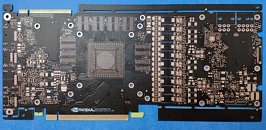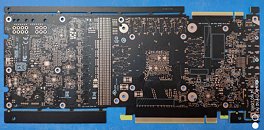Thursday, August 2nd 2018

NVIDIA GeForce GTX 1180 Bare PCB Pictured
Here are some of the first pictures of the bare printed circuit board (PCB) of NVIDIA's upcoming GeForce GTX 1180 graphics card (dubbed PG180), referred to by the person who originally posted them as "GTX 2080" (it seems the jury is still out on the nomenclature). The PCB looks hot from the press, with its SMT points and vias still exposed. The GT104 GPU traces hint at a package that's about the size of a GP104 or its precessors. It's wired to eight memory chips on three sides, confirming a 256-bit wide memory bus. Display outputs appear flexible, for either 2x DisplayPort + 2x HDMI, or 3x DisplayPort + 1x HDMI configurations.
The VRM setup is surprisingly powerful for a card that's supposed to succeed the ~180W GeForce GTX 1080, which can make do with a single 8-pin PCIe power input. The card draws power from a combination of 6-pin and 8-pin PCIe power connectors. There is a purportedly 10-phase VCore side, which in all likelihood is a 5-phase setup with "dumb" phase-doubling; and similarly, a 2-phase memory power (which could again be doubled single-phase). The SLI-HB fingers also make way. There's a new connector that looks like a single SLI finger and an NVLink finger arranged side-by-side. NVIDIA still hasn't given up on multi-GPU. NVLink is a very broad interconnect, in terms of bandwidth. NVIDIA probably needs that for multi-GPU setups to work with not just high resolutions (4K, 5K, or even 8K), but also higher bit-depth, higher refresh-rates, HDR, and other exotic data. The reverse side doesn't have much action other than traces for the VRM controllers, phase doublers, and an unusually large bank of SMT capacitors (the kind seen on AMD PCBs with MCM GPUs).
Sources:
Baidu Tieba, VideoCardz
The VRM setup is surprisingly powerful for a card that's supposed to succeed the ~180W GeForce GTX 1080, which can make do with a single 8-pin PCIe power input. The card draws power from a combination of 6-pin and 8-pin PCIe power connectors. There is a purportedly 10-phase VCore side, which in all likelihood is a 5-phase setup with "dumb" phase-doubling; and similarly, a 2-phase memory power (which could again be doubled single-phase). The SLI-HB fingers also make way. There's a new connector that looks like a single SLI finger and an NVLink finger arranged side-by-side. NVIDIA still hasn't given up on multi-GPU. NVLink is a very broad interconnect, in terms of bandwidth. NVIDIA probably needs that for multi-GPU setups to work with not just high resolutions (4K, 5K, or even 8K), but also higher bit-depth, higher refresh-rates, HDR, and other exotic data. The reverse side doesn't have much action other than traces for the VRM controllers, phase doublers, and an unusually large bank of SMT capacitors (the kind seen on AMD PCBs with MCM GPUs).


57 Comments on NVIDIA GeForce GTX 1180 Bare PCB Pictured
I'm a little afraid that this will cannibalize pro cards for deep learning purposes.
About the phases - I don't see why this cant be a full blown 8+2 design. Its not uncommon. They could also just not solder the extra unusable phases to the controller, much like how its done on 1080:
die estimation 360?
officially gddr6 measures 14x12 mm, 5x 14x10.
Let me just add, I don't think the card above is a GTX 2080. The specs don't really add up. I think it's a Quadro of sorts.
Looking at that PCB you can see those memory placements are indeed BGA-180 packages, so yeah definitely GDDR6.
GTX 1080 has PCB number 180-1G413-DAAA-A00 where this PCB is 180-1G180-DAAA-A02. Looks like an iteration on the previous design.
One DP port can be replaced by an HDMI port. (second from top)
One DP port can be replaced by what appears to be a USB-C port. (lowest one)
Finally the bottom tow DP ports seems to be replaceable by a port I don't recognise, that's set further back on the PCB. It's possible it's a D-Sub connector, but that would surely be madness, no?
8800 GTS - 320-bit - 320/640MB (cut-down from 384-bit)
8800 GTX - 384-bit - 768MB
GTX 260/275 - 448-bit - 896/1792MB (cut down from 512-bit)
GTX 460/460 v2 - 192-bit - 768/1536MB (cut down from 256-bit)
GTX 480/580 - 384-bit - 1536/3072MB
GTX 470/570 - 320-bit - 1280MB (cut down from 384-bit)
GT 545 - 192-bit - 1536/3072MB
Quadro FX 5600 - 384-bit - 1536MB
Quadro 6000 - 384-bit - 6144MB
Nothing new to nVidia. They've been doing this for over a decade, and will continue to.
DAAA is nVidia's test pattern notation.180 is their PCB signature, and 1GXXX is where the real info is. So 1G180 (PG180) is what tells us this is a completely new design,DAAA tells us it's a test pattern, and A02 just says it's the second test pattern for PG180. Compare this PCB to a reference GTX 1080 and the similarities are scarce.Test pattern notation does not necessarily get removed from a final revision card, just for clarification. The revision number will generally change if anything is modified. This card is in a secondary stage of modification, but it could remain the final version.Edit: I've been corrected. DAAA is not an indication of test patterns, it appears to be a generational notation starting with Pascal. (occupying what previously was the 11xx marking). My confusion stems from the appearance of DAXXXXXX stickers on many qualification and engineering boards, and I attributed that to the new markings. They are not related.
DisplayPort
DisplayPort or HDMI
DisplayPort
DisplayPort or USB3-C (Thunderbolt 3?)
optional DVI-D single link